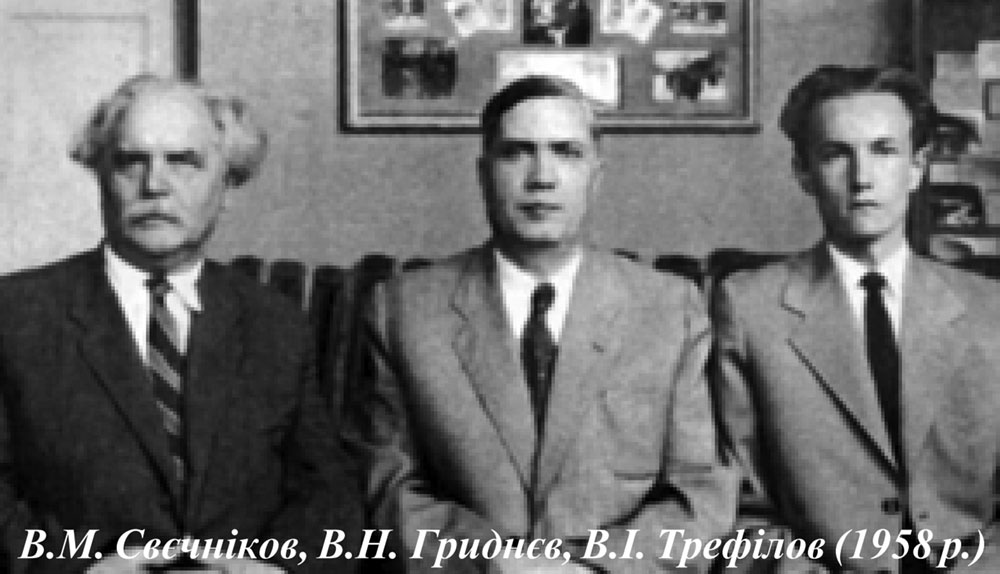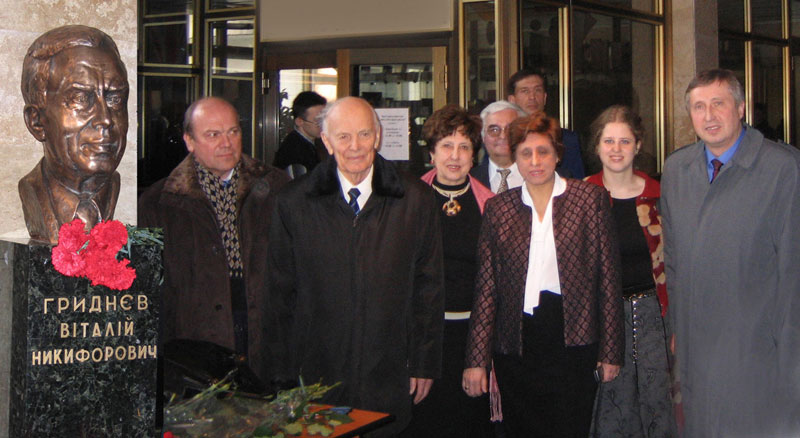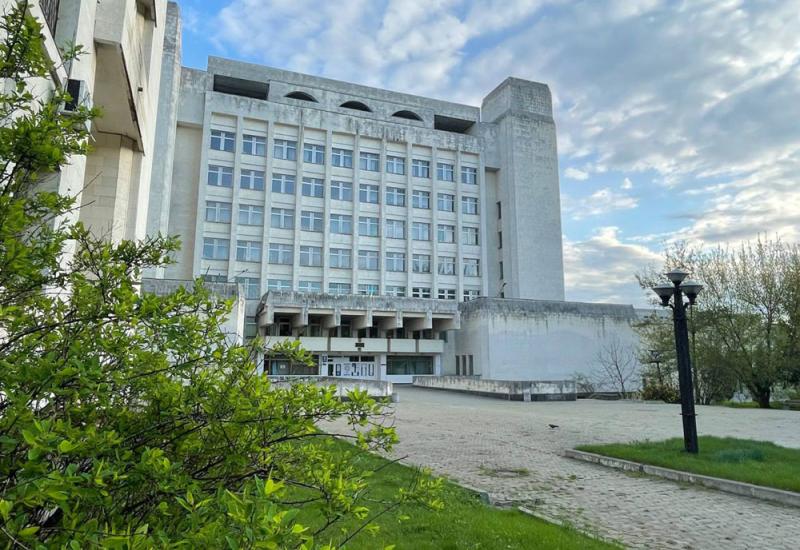The activities of the founding scientific schools of materials science, metallurgy, and welding at KPI were associated with outstanding world-renowned scientists: E.O. Paton, B.E. Paton, V.Y. Vasiliev, M.M. Dobrokhotov, K.I. Vashchenko, V.N. Hrydnev, I.M. Fedorchenko, G.V. Samsonov, V.I. Trefilov, V.V. Skorokhod, I.K. Pohodnya.
In their field, modern scientific schools were formed, which became the basis of the E.O. Paton Institute of Materials Science and Welding of the KPI, whose director, Professor I.A. Vladimirsky, was recently nominated by the Academic Council of the University to participate in the competition for election as a corresponding member of the National Academy of Sciences of Ukraine in the specialty "Materials Science and Technology of Materials".
In the constellation of the founding scientific schools that changed the world of materials that serve humanity, the school of the outstanding metallurgist, State Prize winner, Honored Worker of Science and Technology of Ukraine, Academician V.N. Gridnev (1908-1990), continues to have a charitable impact on the scientific and educational sphere of Ukraine related to materials science.
Academician V.N. Hrydnev laid down many traditions in KPI, including the tradition of cooperation with the institutes of the National Academy of Sciences of Ukraine of physical and material science, which contributes to the development of KPI as a research university today. Therefore, before asking a few questions to Professor I.A. Volodymyrsky in this context, it would be worthwhile to reveal to readers the main features of the scientific and pedagogical school of academician V.N. Gridnev, whose pupil at its current stage I.A. Volodymyrsky sees himself as a pupil
In 1952-1955, V.N. Hrydnev, Director of the KPI, founded the training of engineers in the Department of Metal Physics as an interdisciplinary specialty at the intersection of solid state theory and metallurgy. For many years, it became the basis for providing a personnel reserve for the material science institutes of the National Academy of Sciences of Ukraine.
The needs of the educational process led to the formation of a scientific school in the 50s - 80s of the twentieth century, because according to the scientific and pedagogical views of V.N. Gridnev, science is an integral form of organizing the educational process, the systemic basis of the university's educational activities. The tradition established then is still relevant today.
The concept of the unity of the educational process and research is based on the traditions of well-known European schools in the field of physical metallurgy: Aachen University, Magdeburg University of Technology, Imperial College London, and Ecole Polytechnique in Paris, where in-depth natural science and fundamental training is combined with general engineering disciplines and applied sciences, and professional and practical skills are provided in the scientific field and industry (this is the so-called "physical and technical model" of higher education, which is considered elitist worldwide).
No less significant was V.N. Hrydnev's thesis "Doing science with your own hands" (a graduate of the KPI had to have practical skills as a research engineer). Therefore, V.N. Hrydnev personally paid much attention to the development and implementation of original research methods, strengthening the material base.
In the development of V.N. Hrydnev's scientific school in KPI as a component of the entire materials science complex of KPI, an outstanding role was played by the President of the National Academy of Sciences of Ukraine, Academician B.E. Paton.
With his direct participation, the joint (E.O. Paton Institute of Electric Welding and KPI) International Welding Center, the Faculty of Physics and Technology (today - Institute of Physics and Technology) were created, a decision was made to open a branch of the Department of Metal Physics at the Institute of Metal Physics, and the creation of a joint (KPI and Institute of Materials Science Problems) educational and research laboratory of diffusion in thin layers was supported.
Later, in 2020, Borys Paton supported the idea of merging the Faculty of Engineering Physics and the Faculty of Welding in the form of the Institute of Materials Science and Welding; Borys Paton's family agreed to name the newly created Institute after him.
Since 1991, when the Department of Physics of Metals was headed by Doctor of Physics and Mathematics S.I. Sydorenko, who was a supporter of fundamentalizing the content of educational programs in materials science and the decisive role of scientific research in the educational process, the scientific school has been further developed at KPI on the basis of scientific ideas of Academician V.N. Hrydnev on the role of intensive energy methods of materials processing to give them new properties.

The conceptual foundations of nanoscale materials science are being developed, metastable (but kinetically stable) structural phase states with new properties are being investigated, and technologies for creating functional gradient-layer materials are being developed on this basis.
During these years, prominent scientists were involved in teaching: academicians V.V. Nemoshkalenko (spectroscopy) and A.P. Shpak (new materials), professors V.M. Antonov (computational physics), L.N. Larikov (structure and properties of metals), V.T. Cherepin (surface physics).
Prominent graduates of the Department: Corresponding Members Y.M. Koval, S.P. Oshkadirov, Yu. Milman, O.V. Kurdyumov, V.T. Cherepin, as well as academicians V.G. Baryakhtar, O.M. Ivasyshyn, S.O. Firstov, K.A. Yushchenko, and Professor M.O. Vasiliev provided comprehensive assistance to the department, even when they were not working in its staff. Their names are associated with raising the scientific level of the educational process, improving the curriculum, and developing the concept of the Faculty of Physics and Technology, founded in 1995, in 1993-1995.
This corresponded to both the fundamental ideas of V.N. Gridnev and a number of initiatives to strengthen the position of the physical and technical model of education in the national system of higher education of Ukraine, which was born in the 90s, and to deepen the cooperation of universities with the institutions of the National Academy of Sciences of Ukraine, the organic inclusion of KPI scientific schools in the international educational and scientific space.
In the years of formation of the Faculty of Physics and Technology, the Department of Metal Physics was the basic one in the organization of the educational process in the field of Materials Science.
Students of the Faculty of Physics glorified KPI and the country with bright victories in the world competitions in mathematics and programming.
V.N. Hrydnev's scientific school at KPI was highly effective. It has educated many prominent scientists - scientific leaders and organizers in the system of higher education in Ukraine and the National Academy of Sciences, industry and business. These are academicians V.I. Trefilov, S.O. Firstov, Yu. Solonin, V.V. Nemoshkalenko, Y.V. Naidych, O.M. Dykhne, corresponding members Y.M. Koval, Y.Y. Meshkov, V.T. Cherepin, Y.V. Milman, S.P. Oshkadirov, O.V. Kurdyumov, S.I. Sydorenko. In general, the scientific school of V.N. Hrydnev at Igor Sikorsky Kyiv Polytechnic Institute has trained more than 60 doctors and 300 candidates of sciences.
Since 1991, the Department of Metal Physics (now the Department of Physical Materials Science and Heat Treatment) has trained 27 PhDs (4 more defended their theses abroad), 5 Doctors of Sciences, published more than 800 scientific publications (articles and abstracts at international conferences, 59 patents and copyright certificates, 19 monographs in the publishing houses "Naukova Dumka", Springer, etc.
Thus, even in difficult times, the V.N. Hrydnev School of Science at Igor Sikorsky Kyiv Polytechnic Institute demonstrates the ability to develop. Its long-standing traditions and conceptual foundations are not only preserved in our time, but also further developed.
The correspondent of "Kyiv Polytechnic" had a conversation with the director of the E.O. Paton Institute of Mechanical Engineering Prof. I.A. Volodymyrskyi about this.
- What are the current tasks of the E.O. Paton Institute of Chemical Engineering?
Before talking about the tasks, let me point out that when the E.O. Paton Institute of Materials Science and Welding was created (by combining the Faculty of Engineering Physics and the Faculty of Welding, as well as the Department of Laser Engineering and Physical and Technical Technologies), it was determined that it would be a new type of institute. The novelty lies in the focus on training, retraining and advanced training of specialists based on an innovative model of activity in accordance with the requirements of building a high-tech economy of Ukraine, academic standards and European standards of higher education. This laid the foundation for the idea of the inseparable unity of education, science and innovation, which is a fundamentally new and distinctive feature of the E.O. Paton Institute of Mechanical Engineering compared to many others that were created earlier.
The idea of such unity was inherent in the life and work of Eugene Oskarovych and Borys Yevhenovych Paton as outstanding scientists and educators. Ahead of their time, they seemed to be looking far ahead. We highly appreciate the consent of the Paton family to name our institute after Yevhen Oskarovych.
And the unity of KPI scientific schools in the field of materials science with scientists from the institutes of the National Academy of Sciences is a tradition inextricably linked to the scientific school of V.N. Gridnev, whose student I consider myself to be at the present stage. Here's an example: one third of the PhD and doctoral theses defended by the IMZ scientists are "proved" and tested in collaboration with NAS scientists, and about the same share of articles is published by IMZ scientists in collaboration with NAS scientists.
And one more thing. In order to define the model of a new specialist in accordance with the needs of the innovative high-tech economy of Ukraine, including in the post-war period, strategic planning and promotion of the balanced development of E.O. Paton Institute, the Regulations of our Institute provide for a special role of the Supervisory Board. It consists of very authoritative scientists - heads of the institutes of the National Academy of Sciences of Ukraine (academicians V.Z. Turkevych, S.O. Firstov, V.V. Kharchenko, Corresponding Member V.D. Poznyakov) and a representative of the high-tech industry - Plasmatek PJSC - V.P. Slobodianiuk.
It is difficult to find an analogy of a faculty-level structure in other technical universities that would determine its development strategy on the basis of combining the activities of NASU institutes and industry and, at the same time, analyze how this strategy is being implemented and, if necessary, make adjustments.
Such a deep and dynamic mechanism for organizing the progressive development of the institute is very important for the E.O. Paton Institute of Chemical Engineering, which today is a large educational, scientific and innovative complex within the KPI with a high intellectual potential. It consists of 5 scientific schools, 5 departments, where 18 doctors of sciences, professors, 33 candidates of sciences, associate professors (in total - more than 100 scientific and pedagogical staff) work, and more than 350 students and 35 postgraduate students study.
Despite the fact that the Supervisory Board includes scientists from only four institutes of the Academy (E.O. Paton Electric Welding, I.M. Frantzevych Problems of Materials Science, V.M. Bakul Superhard Materials, H.S. Pysarenko Strength Problems), for five modern scientific schools of the Paton Institute of Materials Science, the Supervisory Board is composed of scientists from the following institutes: the Institute of Materials Science, the Institute of Electric Welding, the Institute of Materials Science, the Institute of Materials Engineering, the Institute of Materials Science, the Institute of Materials Science and Technology, the Institute of Materials Science and Technology of the Institute of Materials Science. E.O. Paton on materials science, metallurgy, welding, close cooperation with all the institutes of physical and material science of the National Academy of Sciences of Ukraine, for example, with the Physical and Technological Institute of Metals and Alloys, the Kurdyumov Institute of Metallophysics, etc. has become a tradition.
- How exactly is this cooperation realized?
The main connecting mechanism of cooperation is a developed contractual base with the institutes of the National Academy of Sciences, as well as the daily work of a large number of joint research groups, creative teams of IMZ scientists with scientists from the institutes of the Academy. These joint research groups traditionally have close ties with industry. Historically, these were primarily enterprises of the military-industrial complex. And strengthening this connection at the new stage is perhaps the most important task for the development of our institute, a factor in its economic and substantive content. The order of the Ukrainian defense industry for specialists necessary to ensure a strong defense and security potential of Ukraine is also our guideline in defining the tasks of the IIR that you are asking about.
In general, our tasks to define the model of a specialist we should train for the needs of the post-war economy are included in the "Comprehensive Program of Strategic Development of the KPI-IEZ-Plasmatek Joint Activity", which is currently being formed.
These key features of our institute's activities also determine the other tasks we face. For example, attracting international grants.
Given the reduction of budgetary funding for science due to the war, funds from international sources have become almost the only source to support existing scientific schools, joint research groups of scientists of the IMZ and the Institutes of the Academy of Sciences, and to develop the educational, laboratory and research facilities.
The work on attracting international funds will be developed jointly with our partner institutes of the Academy and should benefit each creative team of the IIR scientists and scientists of the institutes of the National Academy of Sciences.
Important are the tasks of the IMZ to upgrade the material and technical base of the departments, in particular, together with our partners - high-tech domestic enterprises. Together with PrJSC "Plazmatek" we have already started to solve such a complex task of radical reconstruction of the building №23 - the former welding faculty, founded in KPI by Professor E.O. Paton, and its infrastructure renewal.
I consider it my duty, together with our like-minded management team, to ensure that the tasks are solved in a practical way as soon as possible.

- And finally, a little bit about your own research and the results achieved.
Our research area within the School of Science creates the scientific basis for the technologies of the latest metal nanomaterials, in particular those with special magnetic properties. These results are positively evaluated by the scientific community: more than 100 articles have been published, including more than 40 in international journals of the Q1 and Q2 quartiles (journals with a high impact factor): Adv. Funct. Mater., J. Phys. D: Appl. Phys., Nanotechnol., Comput. Mater. Sci., Vacuum, Appl. Surf. Sci., Thin Solid Films, J. Phys: Cond. Matter, J. Appl. Phys. 2 monographs were published by Springer and Naukova Dumka of the National Academy of Sciences of Ukraine ("Modern Magnetic and Spintronic Materials" and "Diffusion Formation of Nanoscale Magnetic Materials Based on FePt"). Our projects won funding in national and international competitions: 1 - under a grant from the President of Ukraine, 2 - at the expense of the state budget (Ministry of Education and Science of Ukraine), 1 - under the EU Horizon Europe program, 3 - under the NATO Science for Peace and Security program, 3 - from the German Research Foundation (DFG). In 2022, he was awarded the President of Ukraine Prize for Young Scientists. For 7 years he has been a scholarship holder of the Cabinet of Ministers of Ukraine for young scientists.
I plan to use all the experience gained over the years in organizing research and development of materials technologies, including in the international sphere, to deepen cooperation with the scientific centers of our partner institutes of the National Academy of Sciences of Ukraine and high-tech industrial enterprises in order to confirm the concept of the Paton Institute as a new type of educational, scientific and innovative complex of Ukraine in the field of materials science with real deeds.

